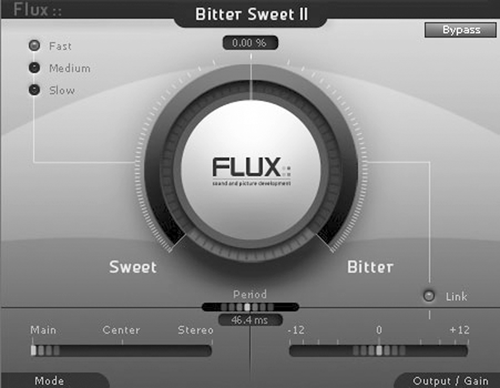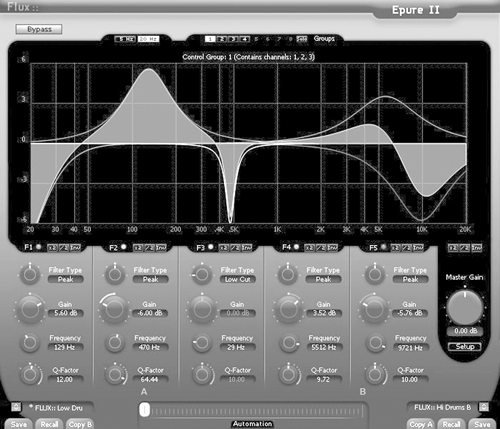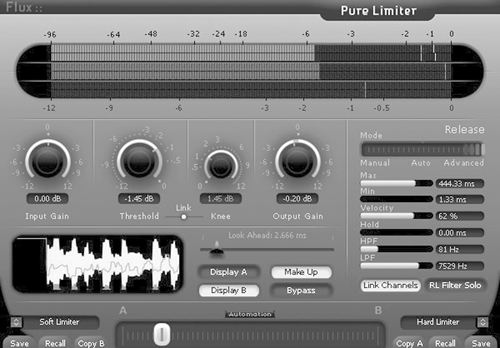By Steve Cunningham
I know I’ve mentioned this several times in previous months, but I’m still in search of alternatives to Waves’ plug-ins and their annual upgrade program fee (cleverly referred to as WUP, or Waves Update Program). As much as I love the Waves plug-ins and how they sound, their habit of charging me every year for the right to continue to use the product that I’ve already paid for grates on me. To be fair, about a year ago they significantly reduced the annual fee, from unbelievable to only slightly usury. Nevertheless, I’m still on the lookout for plug-ins that sound as good as Waves products, but don’t grab my wallet every year.
Over the past several weeks, I’ve test driven a set of plug-ins from a French company known as Flux Sound and Picture Development, or Flux for short. I first ran into their products while scouring the web for free plug-ins. Turns out they make two of them, they work well, and of course the price is right. Flux also make a commercial series of dynamics and EQ plugs which, while a bit quirky, also work well. All of the company’s plug-ins are available for Pro Tools as RTAS and Audio Suite plugs on both Windows and Mac platforms, as well as VST for Windows and Audio Units for Macintosh. They can all handle up to eight channels of audio simultaneously, at sample rates up to 384 kHz.

FREEBIES FIRST
BitterSweet II can best be described as a transient manager. A large dial in the center of the interface governs whether transients are amplified or reduced in volume — turning to the sweet side reduces them, while turning to the bitter side amplifies them. Three LEDs act as select buttons to choose a fast, medium, or slow response in regulating transients. A three position slider in the lower left corner controls whether BitterSweet II works “normally” on both channels of a stereo track (the Main position), or whether it works on one or the other channel in an M/S stereo miking configuration (the Center or Stereo position, respectively).
I know, there’s very little production work done using M/S miking techniques. There’s also very little surround work done in radio production, but like all of Flux’s plug-ins BitterSweet handles up to eight separate channels, so it can do its magic simultaneously on all channels of a surround track. In use, it’s not quite as brash as Sony’s transient modulator plug-in, but I find it effective in taming overly percussive music beds; sometimes all you need to make a music bed sit under the VO is to squash the kick and snare a bit.

The second freebie is a plug called Stereo Tool, which lets you precisely position a sound in the stereo field, or alter the width of an existing stereo track. The center of the interface is home to a large vector scope that graphically displays the phase of a stereo signal. Independent gain and pan controls are provided for each channel, as is a phase switch. PPM meters along the bottom of the interface show you the input and output levels for both the left and right channels, along with the overall phase correlation of the stereo track.
The large horizontal slider at the bottom of the interface shows up on many of Flux’s plug-ins. It’s a Morph control slider, and it lets you gradually changed the parameters of the plug-in between two different settings, A and B. In the case of the Stereo Tool plug, you could adjust it for a very narrow stereo image and store those settings as the A preset, then adjust the plug to create a very wide stereo field and store that as the B preset. Assuming your software editor supports plug-in automation, you could then automate the Morph slider to change the width of the stereo field in real time. As far as I’m concerned, that’s big fun for no money. Don’t wait, just go online and download these babies right now.

NOW THE MONEY
The company’s flagship product, a comprehensive compressor called Solera, weighs in at a cool 400 Euros, which at this writing is just shy of 600 bucks — not a lightweight price (although there’s no annual fee and updates appear to be gratis). It consists of four dynamics processors — a compressor, an expander, a de-compressor, and a de-expander. These processors operate simultaneously in parallel, and each can be independently enabled or bypassed. Each processor has the usual threshold, ratio, range, and knee controls that one would expect on a dynamics processor. They share a common set of timing controls including delay, attack, and release, along with some unique timing controls like Release Minimum and Release Velocity. The former sets the minimum release time when Solera is in Advanced mode and the release time is changing with the input level, while the latter governs how quickly the release time is allowed to change. These in turn are governed by Solera’s adaptive release algorithms, which vary the release time in a frequency dependent manner. Trust me, it’s easier to hear the differences than to explain them.
 Also take note of the metering on the right-hand side of the interface — it’s in the RMS values rather than dBFS, which I like.
Also take note of the metering on the right-hand side of the interface — it’s in the RMS values rather than dBFS, which I like.
RMS reflects how we hear (VU meters basically show RMS), while dBFS is more important for avoiding overs. As a result, these meters are more useful in helping you see the effect of the compressor, but you will need to watch for clipping elsewhere on the mix channel — there are no clipping indicators anywhere on the interface. The two horizontal meters located under the vertical ones are similar to meters found in RNL’s Neodymium limiter plug-in, with the top meter displaying “crest”, or the variation in input dynamics over time, and the bottom meter displaying the amount of change in the release over time.
On the left-hand side you’ll find customary controls for Input and Output level (although I recommend you simply turn on the automatic makeup gain and call it good), and a couple of controls that are far from customary. The so-called “Angel’s Share” control appears to affect how high frequencies are compressed. Increasing Angel’s Share seems to compress high frequencies a little less, resulting in more openness especially at higher levels of compression. The other odd one is labeled Hysteresis, and increasing its setting gives a result similar to turning the Threshold control down during soft passages and back up during loud passages. The result is that some level of compression occurs at all input volumes rather than having no compression at levels below the Threshold setting. Again it’s much easier to hear it than to explain it, but the result is a smoother, more even level of compression that is less audible when you’re doing a serious squash.
Solera also features the aforementioned Morph control, allowing you to automate compression settings between two presets. I think this is less useful here than it is on the Stereo Tool, but it’s not without value. There’s also a comprehensive side chain input, and a Clipper that acts as a brick wall Limiter at 0.01 dBFS. Finally, there is a Mix control along the left-hand side of the curve display, so you can mix some uncompressed signal in with the compressed signal. This allows a rather cool technique known as “parallel compression” which is really effective for maintaining intelligibility in an otherwise crushed voiceover.
 Just because Solera has a control called Angel’s Share doesn’t mean it’s not capable of being abused like any other compressor. Like any hardware compressor, you can crank Solera to the point where it will pump and breathe with the best of them. But when you do, exercise some caution because the lack of a clipping indicator means you can get into dangerous territory without realizing it and digitally clip the next stage in your mix channel, turning your track into the audio equivalent of an industrial accident.
Just because Solera has a control called Angel’s Share doesn’t mean it’s not capable of being abused like any other compressor. Like any hardware compressor, you can crank Solera to the point where it will pump and breathe with the best of them. But when you do, exercise some caution because the lack of a clipping indicator means you can get into dangerous territory without realizing it and digitally clip the next stage in your mix channel, turning your track into the audio equivalent of an industrial accident.
At first it was all a bit much to get my head around, but I like it.
I exercised Solera more as a compressor then as an expander, although it worked rather well at that too. In particular, the de-compressor was gentle yet effective in putting some life back in to a highly compressed music bed. But $600 is a lot of money for a compressor, even one as comprehensive as this...
CHIPS OFF THE BLOCK
...which is why I was happy to see the Pure collection of plug-ins.
Flux broke Solera’s four modules into individual plugs, each of which is priced at 100 Euros. Since I was most impressed with the compressor, and it was nice to see that I could have that as an individual plug for about 150 bucks. Much more in my price bracket.
Each of these four modules — Pure Compressor, Pure DCompressor, Pure Expander, and Pure DExpander — behaves almost exactly the same as does its counterpart in Solera. They even have the Morph control for switching between presets. The only downside is that their interface is rather narrow, which makes it harder to read some of the graphical displays. But you can adjust knobs by either grabbing them with a mouse, or by double-clicking on the numeric value and typing, so they’re only slightly more difficult to use, and a lot less than expensive than buying the Big Gun.
The one additional plug in the Pure series is Pure Limiter. Based on the same algorithms as Solera, it’s one of the more transparent limiters I’ve ever heard. It also features a unique display that allows you to see either both the original and the limited waveforms, or the limited waveform and a graph of the release values. Pure Limiter takes advantage of the same adaptive release algorithms as are found in Solera, allowing you to maximize your track volume without making the effect too obvious. The limiting process is simple enough, but a good limiter that does its job without being audible is uncommon. Pure Limiter fits this description.

PURE EQ
The other big gun in Flux’s holster is Epure II, a five band EQ with a number of features that set it apart. As you might expect, it has the common Morph control like its siblings. But the interface does something interesting that I’ve not seen anywhere else — the display changes its resolution as you change the gain on a frequency band. So if the level scale shows plus or minus 9 dB and you increase the gain on a frequency band by 6 dB, the level axis will scale itself to show you a max of 12 dB. Like the other Flux plug-ins, Epure II handles up to eight channels simultaneously for surround use, and these channels can be linked together in a manner that is completely flexible. It gives you 24 dB of boost or cut, and Q values from 0.1 to 10 for creating surgically narrow cuts. At a price of 400 Euros, Epure II is not a cheap EQ. What it is is transparent, flexible, and very effective.

For me, the value winners in the Flux line are the Pure Compressor and the two freebies, BitterSweet II and Stereo Tool. If I had a few extra bucks I’d be tempted to add the DCompressor to help deal with some of the lame music beds my clients provide. The other Flux plug-ins are nice, but for me those three are the money. Steve sez check ‘em out.
Solera and Epure carry a suggested retail price of 400 Euros. The Pure Series, including the Pure Limiter, retail for 100 Euros each.
Flux has several bundles of different plug-ins available on their website, www.fluxhome.com, where you can find more information on the products, or download a demo version.
♦
